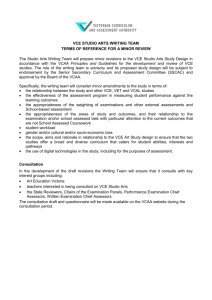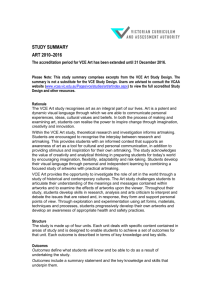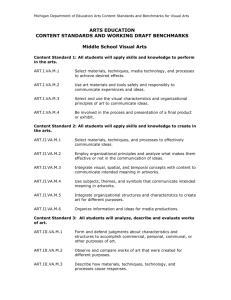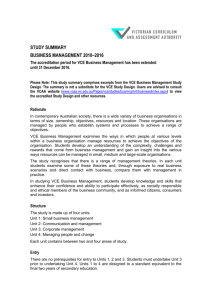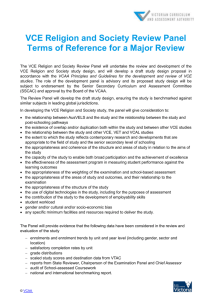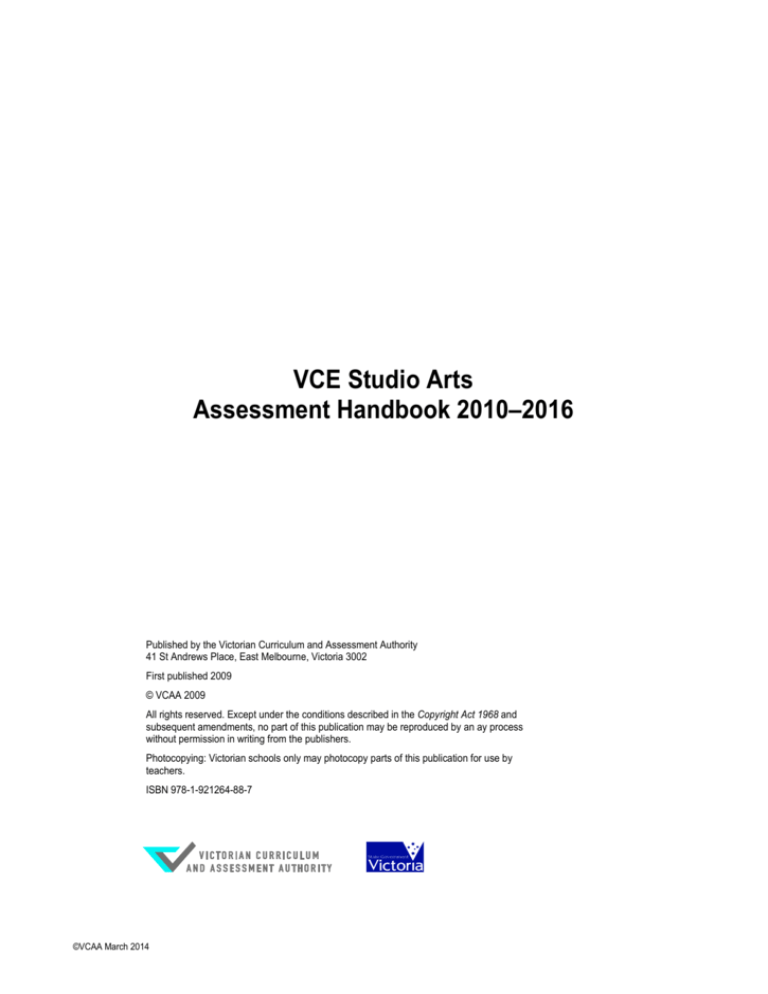
VCE Studio Arts
Assessment Handbook 2010–2016
Published by the Victorian Curriculum and Assessment Authority
41 St Andrews Place, East Melbourne, Victoria 3002
First published 2009
© VCAA 2009
All rights reserved. Except under the conditions described in the Copyright Act 1968 and
subsequent amendments, no part of this publication may be reproduced by an ay process
without permission in writing from the publishers.
Photocopying: Victorian schools only may photocopy parts of this publication for use by
teachers.
ISBN 978-1-921264-88-7
©VCAA March 2014
Contents
Introduction .......................................................................................................................... 3
Assessment .......................................................................................................................... 4
VCE assessment principles........................................................................................ 4
Assessment tasks ...................................................................................................... 6
Scope of tasks .................................................................................................... 6
Designing the assessment tasks ........................................................................ 6
Making assessment part of teaching and learning ............................................. 6
Studio Arts Assessment Advice and Further Resources ................................................ 8
School-assessed Tasks ............................................................................................. 8
Unit 3 .................................................................................................................. 8
Unit 4 .................................................................................................................. 9
Sample approaches to Unit 3 Outcome 3 and Unit 4 Outcome 3 ............................ 10
Unit 3 ................................................................................................................ 10
Unit 4 ................................................................................................................ 17
Further Resources.................................................................................................... 20
Examination ...................................................................................................... 20
Publications ...................................................................................................... 20
©VCAA March 2014
VCE Studio Arts
ASSESSMENT HANDBOOK 2010–2016
Introduction
The VCE Studio Arts Assessment Handbook 2010–2016 contains assessment
information for both school-based assessment and the examination in Studio Arts
and advice for teachers on how to construct assessment tasks. Advice on matters
related to the administration of VCE assessment is published annually in the VCE
and VCAL Administrative Handbook. Updates to matters related to the
administration of VCE assessment is published in the VCAA Bulletin VCE, VCAL
and VET. Teachers must refer to these publications for current advice.
Units 1 and 2
In Studio Arts the student’s level of achievement in Units 1 and 2 is a matter for
school decision. Assessment of levels of achievement for these units will not be
reported to the Victorian Curriculum and Assessment Authority (VCAA). Schools
may choose to report levels of achievement using grades, descriptive statements
or other indicators.
Units 3 and 4
The VCAA will supervise the assessment of all students undertaking Units 3 and 4.
In Studio Arts the student’s level of achievement will be determined by two Schoolassessed Tasks and an end-of-year examination. The VCAA will report the student’s
level of performance on each of three Graded Assessment components: Unit 3
School-assessed Task, Unit 4 School-assessed Task and the end-of-year
examination as a grade from A+ to E or UG (ungraded).
This assessment handbook is published in online format only and provides advice
specifically for Units 3 and 4.
Updates to the online assessment handbook are published in the VCAA Bulletin
VCE, VCAL and VET.
Teachers are advised that there may be minor errors in the contents page due to
software version differences.
©VCAA March 2014
3
ASSESSMENT HANDBOOK 2010–2016
VCE Studio Arts
Assessment
VCE assessment principles
Assessment is an integral part of teaching and learning that, at the senior
secondary level:
identifies opportunities for further learning
describes student achievement
articulates and maintains standards
provides the basis for the award of a certificate.
As part of VCE studies, assessment tasks enable:
the demonstration of the achievement of an outcome or set of outcomes
judgment and reporting of a level of achievement on a task or collection of
tasks for School-assessed Coursework, School-assessed Tasks or
examinations.
Monitoring the results of VCE assessment also provides feedback that informs
curriculum implementation, assessment design and curriculum review.
In each VCE study, teachers and schools determine the assessment tasks to be
used at Units 1 and 2. In Units 3 and 4, specified assessment tasks are set.
At the Units 3 and 4 level of a VCE study, School-assessed Coursework, Schoolassessed Tasks and examinations provide assessment results that are used in the
calculation of a student’s study score.
The following are the principles that underpin all VCE assessment practices. These
are extracted from the VCAA Principles and guidelines for the development and
review of VCE Studies.
VCE assessment will be valid
This means that it will enable judgments to be made about demonstration of the
outcomes and levels of achievement on assessment tasks fairly, in a balanced way
and without adverse effects on the curriculum or for the education system. The
overarching concept of validity is elaborated as follows.
VCE assessment should be fair and reasonable
Assessment should be acceptable to stakeholders – including students, schools,
government and the community. The system for assessing the progress and
achievement of students must be accessible, effective, equitable, reasonable and
transparent.
4
©VCAA March 2014
VCE Studio Arts
ASSESSMENT HANDBOOK 2010–2016
Assessment instruments should not assess learning that is outside the scope of a
study design.
Each assessment instrument (for example, examination, assignment, test, project,
practical, oral, performance, portfolio, presentation or observational schedule)
should give students clear instructions. It should be administered under conditions
(degree of supervision, access to resources, notice and duration) that are
substantially the same for all students undertaking that assessment.
VCE assessment should be equitable
Assessment instruments should neither privilege nor disadvantage certain groups
of students or exclude others on the basis of gender, culture, linguistic background,
physical disability, socioeconomic status and geographical location.
Assessment instruments should be designed so that, under the same or similar
conditions, they provide consistent information about student performance. This
may be the case when, for example, alternatives are offered at the same time for
assessment of an outcome (which could be based on a choice of context) or at a
different time due to a student’s absence.
VCE assessment will be balanced
The set of assessment instruments used in a VCE study will be designed to
provide a range of opportunities for a student to demonstrate in different contexts
and modes the knowledge, skills, understanding and capacities set out in the
curriculum. This assessment will also provide the opportunity for students to
demonstrate different levels of achievement specified by suitable criteria,
descriptors, rubrics or marking schemes.
Judgment about student level of achievement should be based on the results from
a variety of practical and theoretical situations and contexts relevant to a study.
Students may be required to respond in written, oral, performance, product, folio,
multimedia or other suitable modes as applicable to the distinctive nature of a
study or group of related studies.
VCE assessment will be efficient
The minimum number of assessments for teachers and assessors to make a
robust judgment about each student’s progress and learning will be set out in the
study design. Each assessment instrument must balance the demands of precision
with those of efficiency. Assessment should not generate workload and/or stress
that unduly diminish the performance of students under fair and reasonable
circumstances.
©VCAA March 2014
5
ASSESSMENT HANDBOOK 2010–2016
VCE Studio Arts
Assessment tasks
Students should know in advance how and when they are going to be assessed
and the conditions under which they will be assessed.
Assessment tasks should be part of the teaching and learning program. For each
assessment task students should be provided with the:
type of assessment task and approximate date for completion
time allowed for the task
allocation of marks
nature of any materials they can utilise when completing the task
opportunity to demonstrate the highest level of performance.
Following an assessment task:
teachers can use the performance of their students to evaluate the teaching
and learning program
a topic may need to be carefully revised again prior to the end of the unit to
ensure students fully understand the key knowledge and skills required in
preparation for the examination.
Feedback provides students with important advice about which aspect or aspects
of the key knowledge they need to learn and in which key skills they need more
practice.
Scope of tasks
Assessment tasks must be a part of the regular teaching and learning program and
must not unduly add to the workload associated with that program. They must be
completed mainly in class and within a limited timeframe. Where there is a range of
options in assessment tasks, teachers must ensure that they are comparable in
scope and demand. Teachers should select a variety of assessment tasks for their
program to reflect the key knowledge and key skills being assessed and to provide
for different learning styles.
Designing the assessment tasks
Designing an assessment task is an important part of the teaching, learning and
assessment process. The assessment task needs to provide the opportunity for all
students to demonstrate the highest level of performance on the outcome.
Teachers should design an assessment task that is representative of the content
(key knowledge and skills underpinning the outcome).
Making assessment part of teaching and learning
Step 1: Define the parameters of an outcome and its related assessment task
options.
This involves listing the key knowledge and skills that will be assessed by the
outcome. These are stated in the study design but you may wish to reword them
for student purposes.
6
©VCAA March 2014
VCE Studio Arts
ASSESSMENT HANDBOOK 2010–2016
Step 2: Determine teaching and learning activities
Identify the nature and sequence of teaching and learning activities to cover the
key knowledge and skills outlined in the study design. It is important that a variety
of learning opportunities are provided to cater for individual preferred learning
styles. (Refer to the ‘Advice for teachers’ section of the study design for some
specific examples of learning activities for each outcome.)
Step 3: Design the assessment task
The specifications of the School-assessed Task are provided in the Studio Arts
Study Design.
Conditions for the task
It is important that students know what is expected of them in an assessment
task. This means providing students with advice about the outcome’s key
knowledge and skills to be assessed. This allows students to understand
during the teaching and learning stage what they are expected to know or do.
Students should be advised about the conditions under which they will be
expected to do the task.
Teachers can develop their own rules, consistent with school policies, about
the material that can be brought into the room and the use of textbooks. Make
sure that these rules are given to the students before the task is started and
preferably in writing.
One method of authentication is to collect the work at the end of each period
and keep it in an individual plastic folder, workbook or folio.
Points to consider
When constructing a task you will need to consider the following:
Will students select the form of the response or will you select the form that the
whole class will use?
Will the task be completed in one lesson or over several lessons? If the task is
going to run over several lessons will you divide the task into parts or collect
students’ work at the end of each lesson? If your school has multiple Studio
Arts classes and your task is designed to last several lessons will you slightly
alter the task for each class?
©VCAA March 2014
7
ASSESSMENT HANDBOOK 2010–2016
VCE Studio Arts
Studio Arts Assessment Advice and Further Resources
School-assessed Tasks
Unit 3
Assessment of levels of achievement
The student’s level of achievement in Unit 3 will be determined by a Schoolassessed Task and an end-of-year examination.
Contribution to final assessment
The school-assessed task for Unit 3 will contribute 33 per cent.
The level of achievement for Units 3 and 4 is also assessed by an end-of-year
examination, which will contribute 34 per cent.
School-assessed Task 1
The School-assessed Task in Unit 3 of Studio Arts encompasses
Outcomes 1 and 2. This School-assessed Task will be assessed by the
teacher using criteria published annually on the Studio Arts study page on
the VCAA website. Details of School-assessed Task 1 are set out in the
following table.
Outcomes
Outcome 1
Prepare an exploration proposal that
formulates the content and
parameters of an individual design
process, and that includes a plan of
how the proposal will be undertaken.
Outcome 2
Present an individual design process
that produces a range of potential
directions, which reflects the
concepts and ideas documented in
the exploration proposal.
8
School-assessed Task 1
An exploration proposal and a
developmental folio (including a visual
diary) that presents an individual design
process, which explores and develops
the concepts and ideas set out in the
exploration proposal, and produces a
creative range of visual explorations and
potential directions that will form the
basis of artworks in Unit 4.
©VCAA March 2014
VCE Studio Arts
ASSESSMENT HANDBOOK 2010–2016
Unit 4
Assessment of levels of achievement
The student’s level of achievement in Unit 4 will be determined by a schoolassessed task and an end-of-year examination.
Contribution to final assessment
The School-assessed Task for Unit 4 will contribute 33 per cent.
The level of achievement for Units 3 and 4 is also assessed by an end-of-year
examination, which will contribute 34 per cent.
School-assessed Task 2
The School-assessed Task in Unit 4 of Studio Arts encompasses Outcomes 1 and
2. This School-assessed Task will be assessed by the teacher using criteria
published annually on the Studio Arts study page on the VCAA website. Details of
School-assessed Task 2 are set out in the following table.
Outcomes
Outcome 1
Present a cohesive folio of finished
artworks, based on selected potential
directions developed through the
design process, that demonstrates
skilful application of materials and
techniques and that realises and
communicates the student’s ideas.
Outcome 2
Provide visual and written
documentation that identifies the folio
focus and evaluates the extent to
which the finished artworks reflect the
selected potential directions, and
effectively demonstrate a cohesive
relationship between the works.
School-assessed Task 2
A cohesive folio of finished artworks
and an evaluation of the finished
cohesive folio.
Teachers will provide to the VCAA a single score representing an assessment of
the student’s level of achievement for Outcomes 1 and 2 in Unit 3 and a single
score for Outcomes 1 and 2 in Unit 4. The score must be based on the teacher’s
assessment of the student’s performance according to the criteria published
each year on the Studio Arts study page on the VCAA website. The completed
assessment sheet for each student’s School-assessed Tasks must be available on
request by the VCAA. This assessment will be subject to review by a panel
appointed by the VCAA. Schools will be notified of the specific dates for review.
Details of authentication requirements and administrative arrangements for the
School-assessed Task will be published annually on the Studio Arts study page
and the current year’s VCE and VCAL Administrative Handbook.
©VCAA March 2014
9
ASSESSMENT HANDBOOK 2010–2016
VCE Studio Arts
Sample approaches to Unit 3 Outcome 3 and Unit 4 Outcome 3
Outcome 3 for both Unit 3 and Unit 4 are assessed by an end-of-year examination.
Teachers may determine assessment tasks for Unit 3 Outcome 3 and Unit 4
Outcome 3 to monitor the progress and work of their students, within the
parameters specified in the Studio Arts Study Design. Assessment tasks such as
reports, essays, short and extended responses to structured questions and oral
presentations should be representative of the content (key knowledge and skills
underpinning the outcome).
Assessment tasks should be part of the regular teaching and learning program and
should not add unduly to student workload.
The teaching and learning program preceding assessment tasks should involve
such strategies as:
short classroom activities
assignments, where students complete research and/or prepare notes in
response to specific questions and/or under headings derived from the key
knowledge and skills in relation to the outcome
formal classroom instruction and group discussions that review content and
produce classroom notes
visits to galleries and exhibitions.
The VCAA does not endorse any individual gallery or artist. In the following advice
references to specific galleries and artists are provided as examples only.
Unit 3: Professional art practices and styles
Outcome 3
Discuss art practices in relation to particular artworks of at least two artists
and analyse ways in which artists develop their styles.
Typical forms of evidence may include a combination of the following:
a collection of annotated research materials
responses to structured questions
an annotated visual report
an essay
an oral presentation.
Teaching approach one
Artists’ styles are influenced by historical and/or cultural contexts and
personal influences. Styles can be recognised through the use of materials,
techniques and processes in the creation of an artwork.
10
©VCAA March 2014
VCE Studio Arts
ASSESSMENT HANDBOOK 2010–2016
Two or three examples of artworks are selected from different historical and
cultural contexts at the beginning of class for discussion. Students are expected to
study at least two artists. The aim is to develop skills in examining, describing,
analysing and evaluating artworks using both theoretical and practical approaches.
A variety of media may also be introduced where students in the class are working
across a range of art forms.
The activities below suggest ways in which this teaching approach may be
implemented:
APPROACH
ACTIVITY
Introduce art elements and
discuss how they are
employed in specific
artworks to demonstrate
aesthetic qualities.
Elements include line,
colour, texture, tone, form,
shape, movement, sound,
light and extend to other
conventions such as
perspective and
composition. Selected
artworks could relate to
students’ particular interests
or reflect the specific
techniques they are
undertaking in relation to
their practical investigations
in their own design process.
Selected artworks may also
be identified and discussed
on location when visiting
exhibitions and gallery
spaces.
Initial discussion of art elements through short
classroom activities such as:
– defining the elements through research and
discussion.
– identifying and discussing examples of how the
elements are used in specific artworks.
Discuss art elements in relation to interpretations of
subject matter, employment of materials,
techniques, processes and the development of
aesthetic qualities and styles.
Identification and discussion of how artists from
different historical contexts have used the same
elements to produce different aesthetic qualities
and styles.
Undertake a range of
activities, each focusing on
a single art element such as
line, colour, texture, tone,
form, shape, movement.
Make a set of individual flash cards from a series of
printed artworks, for example colour inserts from
previous examination papers, samples of artworks
related to student interests or collected from gallery
guides or exhibition marketing material. The flash
cards should include information about the artwork
to support student discussion including the name
and background of the artist, technique used, title
and date artwork was made.
In small groups students select two different flash
cards, engage in a discussion around a specified
art element and explain how it is evidenced in the
artworks. For example, when discussing the art
element colour:
– What types of colour/s have been used?
– What is the intensity of the colour/s?
– How have they been used and what effect do
they create?
– Do they have any historical or cultural
significance for the artist who used them?
– What do these colours symbolise or signify in the
©VCAA March 2014
Identification and discussion of how artists from
different cultural contexts have used the same
elements to produce different aesthetic qualities
and styles.
As discussions progress students develop an art
vocabulary page that identifies and explains their
understanding of art terminology.
11
ASSESSMENT HANDBOOK 2010–2016
VCE Studio Arts
artwork?
Discuss ways in which
aesthetic qualities and
styles are developed in
artworks.
Students construct an interpretation of the use of
the element in the artwork and write a brief
response.
Responses could be presented to the class or
discussed in small groups. Students should be
encouraged to share their observations as they
examine similar or different interpretations and
extend their skills in analysis and development of
art language and terminology.
Provide information regarding colour theory
including the identification and impact of primary,
secondary, complementary, harmonious,
analogous, monochromatic, cool, warm,
contrasting, neutral, and vibrant colours.
Consider questions such as:
What impact does the art element create in the
artwork, for example, what is the impact of the
combination of colours, textures, shape, line?
What feelings are evoked by the art element?
Do the elements have any symbolic meaning for
the students or is there symbolic meaning created
and intended by the artist’s influences?
What has the artist achieved by using these
elements in combination with specific materials and
techniques, for example, how has the paint been
applied, the fabrics treated, the surface of the
sculpture finished?
Students choose one (or more) flash cards, study them
briefly, then write down three–five single words, or a
phrase, to describe them.
In class discussion:
Provide single examples of a variety of artworks to the
whole class. Note the reactions of students to each
work, recording a list of words and phrases suggested
by the students.
The students may respond by analysing the technical
aspects visible in the work, or they may respond
directly to its visual or aesthetic appeal. Both reactions
are valuable, and should be discussed.
For example, reactions to Stanley Spencer, Hilda
Welcomed, 1953, oil on canvas could include:
smooth, stylised, patterned, decorative, narrative,
figurative, emotionally warm and soft, rounded
shapes, warm colours, soft, feminine, crowded.
Whereas reactions to Frank Picini, Conventum
Elementum, 2005, digital art, Poser, Adobe Photoshop
could include
12
futuristic, monotone, emotionally fearful, despairing,
balanced composition, symmetrical, contrast of
flesh and mechanical,fantasy figurative,
photographic, masculine.
©VCAA March 2014
VCE Studio Arts
ASSESSMENT HANDBOOK 2010–2016
Using guide questions analyse ways materials,
techniques and/or processes have been employed in
an artwork. For example:
Stanley Spencer, Hilda Welcomed, 1953, oil on
canvas
What is the subject matter?
How has it been addressed in the painting?
What aesthetic qualities support the subject
matter?
What information in the painting suggests it was
made in the 1950s?
How are the materials and techniques of oil
painting employed in the artwork?
How has the artist used oil paint to create textures
and qualities of fabric in the women’s clothing?
Describe the artist’s personal style, how has this
been achieved?
Frank Picini, Conventum Elementum, 2005, digital art,
Poser, Adobe Photoshop
Describe the style of this work?
What aspects of the work may have been
appropriated from photography?
How have digital processes been employed to
create effect?
What is the style of this work?
What aesthetic qualities contribute to this style?
Sample tasks
Describe the style/s of an artist and explain how they have used
aesthetic qualities in their artworks. Refer to at least two artworks in
your response.
Select an artwork and describe:
– style of the artwork
– use of aesthetic qualities
– use of materials and techniques
– your own interpretation of subject matter in the artwork.
Discuss the ways in which two artists have developed aesthetic
qualities and styles in their artworks. In your response refer to at least
two artworks by each of the artists.
Teaching approach two
Students research professional art practices of artists working in different
historical contexts, they examine the development of styles in the artworks
and ways artists have:
interpreted subject matter, influences and their cultural contexts
communicated ideas and meaning in artworks
©VCAA March 2014
13
ASSESSMENT HANDBOOK 2010–2016
VCE Studio Arts
used materials, techniques and processes
developed aesthetic qualities and styles.
In their investigation students undertake research and develop skills in
using appropriate art terminology.
Students select an art form with which they are familiar, and which may
provide the focus for their folio work in Units 3 and 4.
The following form is a useful way of recording and summarising the
different studio art forms when researching art practices of artists.
Students organise notes for each artwork by two artists under headings
such as:
Artist 1
Artist 2
Title and date of artwork/s:
Subject matter
Materials
Ideas and meaning
in artworks
Working methods/
techniques
Use of technology/ digital
media/studio assistants,
artisans, craft/master
craftspeople
Early influences
Later influences
Historical and/or cultural
context
Work environment (for
example, studio workshop,
on-site installation)
Patronage (the influence of
those who commissioned,
and in some cases
determined subject matter)
Comments on the artist’s
style/aesthetic qualities
14
©VCAA March 2014
VCE Studio Arts
ASSESSMENT HANDBOOK 2010–2016
Sample tasks
Identify two artists and describe their interpretation of subject matter in two
artworks.
Choose an artwork and explain how materials and/or techniques have
contributed toward the artist’s style.
Teaching approach three
Students select two artworks by each artist:
John Brack, 1920–1999, Australia, The Bar, 1954; Collins St. 5p.m., 1955
Support resources available at: www.ngv.vic.gov.au/johnbrack/education/
Henri de Toulouse-Lautrec, 1864–1901, France, At the Moulin Rouge,
1892/95, At the Circus Fernando: The Ringmaster, 1888
Further resources are available at:
www.artic.edu/artexplorer/search.php?tab=1&resource=61128
In groups with one student acting as a scribe and another as spokesperson for the
group, students discuss:
the communication of ideas and meaning in the artworks
use of material/s and technique/s
aesthetic qualities
development of style.
Sample tasks
Discuss the periods, styles and intentions of the works by Brack and ToulouseLautrec. The teacher might provide information about the images in terms of
how they were made, when, and for what purpose. Discussion should focus on
historical and cultural contexts.
Complete a research report exploring the art practices of Australian John Brack
and that of French Henri de Toulouse-Lautrec. Include reference to the use of
aesthetics in developing the style of their artworks.
Explore the subject matter of each artist. How have they interpreted their
surroundings and environment? What impact has time and place had on the
subject matter? Did their subject matter reflect society of the time? What was
their working method?
Discuss art practices related to a particular art form evident in at least two
artworks from different historical and/or cultural contexts.
Teaching approach four
Appropriation
Begin discussion by prompting responses from students by using specific artists
who appropriate other artist’s work in the making of new artworks.
A useful resource featuring appropriation is available at:
www.tate.org.uk/collections/glossary/definition.jsp?entryId=23
©VCAA March 2014
15
ASSESSMENT HANDBOOK 2010–2016
VCE Studio Arts
Focus questions
What is the meaning of appropriation, originality, copyright, licensing
agreements?
What legal and ethical obligations are artists required to follow when using
another artist’s work in the making of new artworks?
Copyright laws exist to protect the rights of all artists; this includes visual
artists as well as designers and musicians. What are the considerations artists
may need to review when using someone else’s work to create a new artwork?
Locate examples of appropriation, for example:
–
Dianne Jones is a contemporary Indigenous Australian artist who works in
photomedia. She appropriates Australian iconic characters and images in
artworks replacing them with images of herself and her family. For
example, Tom Roberts, Shearing the Rams, 1890 – appropriation 2001,
Max Dupain, Sunbaker 1937 – appropriation 2001.
Further information is available at:
www.niagara-galleries.com.au/artists/artistpages/theartists/jones/jonesframe.html
–
Anne Zahalka is a contemporary Australian artist who works in
photomedia. Her photographic portraits of 1987–2007 include The bathers,
1989 an appropriation of Max Dupain, Sunbaker 1937.
Further information is available at:
www.ngv.vic.gov.au/australianimpressionism/education/insights_cviews.html
www.ozarts.com.au/artists/anne_zahalka
www.portrait.gov.au/site/exhibition_subsite_zahalka.php
Sample tasks
Analyse two artworks by artists who have used appropriation in the making of
new artworks. For example, select artworks from Australian artists Imants
Tillers, Lindy Lee, Gordon Bennett, Fiona Foley and other artists, Marcel
Duchamp, Roy Lichtenstein, Robert Raushenberg, Jasper Johns, Jeff Koons,
Damian Hirst and Banksy.
Discuss and give examples of the ways artists use the work of other artists in
the making of new artwork. Refer to the work of at least two artists.
Is it appropriate for artists to use other artists’ work in the making of new
artworks? With reference to specific laws and ethical considerations, use
examples to support your answer.
16
©VCAA March 2014
VCE Studio Arts
ASSESSMENT HANDBOOK 2010–2016
Unit 4: Art industry contexts
Outcome 3
Examine and explain the preparation and presentation of artworks in at least two
different exhibition spaces, and discuss the various roles, processes and methods
involved in the exhibition of artworks.
Typical forms of evidence may include a combination of the following:
a collection of annotated research materials
responses to structured questions
an annotated visual report
an essay
an oral presentation.
Teaching approach one
Students research aspects of the preparation and presentation of two different
exhibition spaces with reference to:
Curatorial factors – consider related factors such as:
– presenting related artworks in the most effective way, for example,
stylistically, aesthetically, thematically or chronologically
– accountability to other parties, gallery owners, designers, artists
– the various roles involved in curating exhibitions.
Exhibition design – consider related factors such as:
– marketing the exhibition to a specific audience/s
– the number of potential viewers
– displaying artworks in the most effective groupings, under appropriate
lighting conditions and against appropriately coloured backgrounds
– specific thematic approaches or with consideration to specific constraints
for example projections inside installations.
Promotion – consider related factors such as:
– marketing strategy
– advertising
– sponsorship
– links with other events
– relationship with other exhibitions and/or displays in the gallery or space or
in another environment.
As part of their research students must visit at least two exhibitions.
Students could also compare approaches to the preparation and presentation of
exhibitions at a variety of art exhibition spaces, for example:
national galleries, artist run initiatives, artist cooperatives
organisations that provide support to artists such as the Gertrude
Contemporary Art Spaces, Boomalli Aboriginal Artists Cooperative, Australian
Print Workshop
exhibitions that focus on artworks from a particular cultural context for
example, Aboriginal and Torres Strait Islander galleries
galleries devoted to a single media, for example, Australian Centre for the
Moving Image, Centre for Contemporary Photography and Experimenta
©VCAA March 2014
17
ASSESSMENT HANDBOOK 2010–2016
VCE Studio Arts
exhibitions of media and technology based art both in exhibition spaces and
online, specifically digital media artworks created primarily for presentation in
web formats and as part of curated projects.
www.experimenta.org/commissionedwork.html
Sample focus questions:
How do the specific media and technical aspects of artworks affect the exhibition
design?
What are the objectives and responsibilities of the curator? To what degree are
considerations of artist/s accommodated?
How is the exhibition promoted to the target audience?
Teaching approach two
Students research a number of different galleries and styles of exhibition spaces.
Students visit galleries and art spaces in Melbourne or regional centres. A list of
resources relevant to the VCE Studio Arts Study Design is available from the
VCAA website Studio Arts study page. It lists locations of galleries and a range of
other resources.
Art Almanac – a guide to Australian Galleries also provides a useful resource
www.art-almanac.com.au
Students collect information under specific headings to support submission of a
written and/or oral report. For example:
the main characteristics of each gallery
the approach for exhibiting artworks; how are artworks selected for exhibition?
the role of the curator and other roles involved in maintaining an exhibition or
maintaining a gallery
how does the gallery/exhibition space deal with conservation and preservation
issues?
how the gallery/exhibition space deals with promotion and marketing,
exhibitions, artists and artworks.
Teaching approach three
Students:
compile an ‘Art Industry’ file using information from daily papers, television
programs, art magazines, websites etc. The file could focus on:
– galleries and other art spaces, with such sub-headings of roles of each,
preserving artists’ work, presenting artists’ work
– presentation, promotion, marketing and public perception of art
(incorporating responses to specific artworks, artists and exhibitions). How
galleries feature work in daily newspapers, expose to a wider audience for
specific artists
analyse, annotate and summarise the material they have collected
present a report about the difference between the galleries visited and the
values of visiting an exhibition first hand. Some questions to consider:
– What was the layout and design of the exhibition?
– How did this affect the viewing or display of the artworks?
– Was conservation a consideration in the display of artworks?
– Was transportation of artworks required? How was this handled? What is a
condition report?
– What role did the curator play?
18
©VCAA March 2014
VCE Studio Arts
–
–
ASSESSMENT HANDBOOK 2010–2016
How was the exhibition marketed/promoted?
How were the artists views and interests accommodated in the exhibition?
Sample tasks
Short answer questions
1. Discuss methods and/or considerations involved in the preparation and
presentation of exhibitions and/or displays at public galleries, commercial
galleries and/or other art spaces visited this year. In your response describe
work undertaken in specific roles of gallery staff.
2. Describe the roles of the following art industry professionals in relation to an
exhibition visited this year:
exhibition designer
curator.
3. List two major differences in the functions of public galleries, commercial
galleries and artist run initiatives.
4. Why is the preservation of artwork important? Describe at least two
approaches to preserving artworks in relation to a specific art form examined in
an exhibition visited this year.
Essay topics
5. Discuss presentation methods used to display artwork to maximise its impact
on an audience with reference to an exhibition visited this year.
6. Discuss an exhibition visited this year in relation to the marketing and
promotion and presentation of artworks in relation to the following:
role of artist
role of curator/gallery manager/owner
key ideas and/or concerns
the viewing audience
role of the graphic designer.
7. Discuss the role of emerging technologies in support of exhibition of media and
technology based artworks.
Identify and discuss how emerging artists might use technology to present
their artworks to a wider audience?
©VCAA March 2014
19
ASSESSMENT HANDBOOK 2010–2016
VCE Studio Arts
Further Resources
Examination
End-of-year written examination
The examination will be set by a panel appointed by the Victorian Curriculum and
Assessment Authority. All the key knowledge and key skills that underpin Outcome
3 in Unit 3 and Outcome 3 in Unit 4 are examinable.
Conditions
The examination will be completed under the following conditions:
Duration: one and half hours.
Date: end-of-year, on a date to be published annually by the Victorian
Curriculum and Assessment Authority.
Victorian Curriculum and Assessment Authority examination rules will
apply. Details of these rules are published annually in the VCE and
VCAL Administrative Handbook.
The examination will be marked by assessors appointed by the
Victorian Curriculum and Assessment Authority.
Contribution to final assessment
The examination will contribute 34 per cent.
Further advice
The Victorian Curriculum and Assessment Authority publishes specifications for all
VCE examinations on the Victorian Curriculum and Assessment Authority website.
Examination specifications include details about the sections of the examination,
their weighting, the question format/s and any other essential information. The
specifications are published in the first year of implementation of the revised Units
3 and 4 sequence together with any sample materials.
Publications
Regular updates and study advice are published in the VCAA Bulletin VCE, VCAL
and VET and on the VCAA website. Teachers should also refer to the following
publications for assessment of VCE Studio Arts:
VCE Studio Arts Study Design 2010–2016
The course developed and delivered to students must be in accordance with the
VCE Studio Arts Study Design, accredited 2010–2016.
The ‘Advice for teachers’ section contains sample learning activities for Units 1 to 4
and suggested tasks.
VCAA website
Teachers are advised to keep up-to-date with developments in VCE Studio Arts by
accessing the Studio Arts study page on the VCAA website.
VCE Examination Papers
Examination papers for all studies are published on the VCAA website.
20
©VCAA March 2014
VCE Studio Arts
ASSESSMENT HANDBOOK 2010–2016
Assessment Reports
The Assessment Reports are published on the VCAA website and provide
teachers with feedback on the examination for Units 3 and 4.
©VCAA March 2014
21


